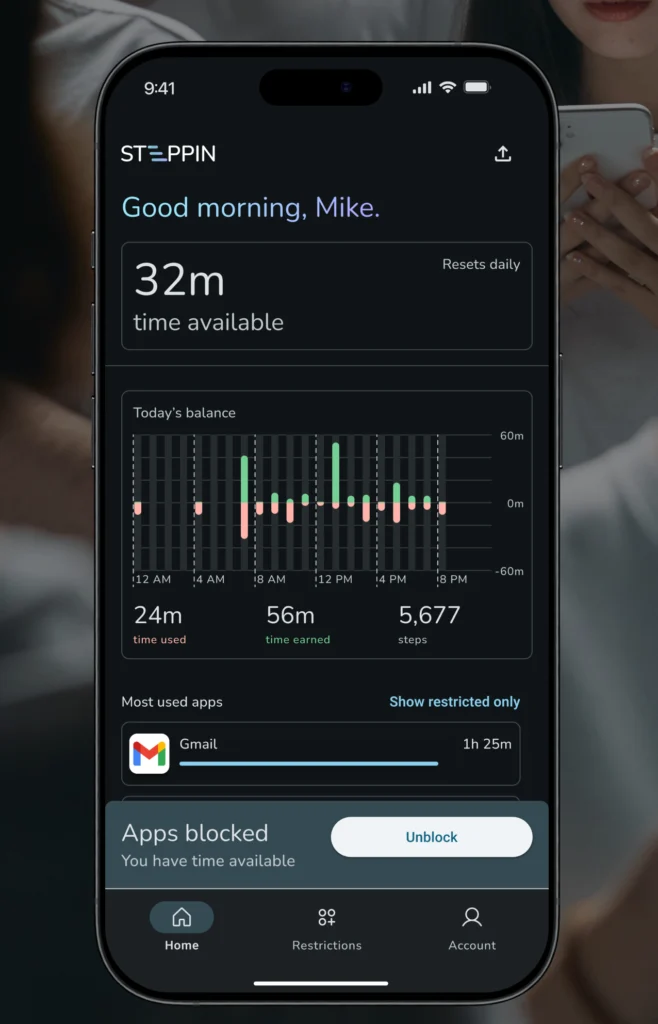Is Steppin the App That Will Finally Get People Off Their Phones?

Created by Kayak co-founder Paul English, Steppin makes people earn their screen time by walking
The smartphone era has its ups and downs. We’re more informed than ever, but many people struggle to break free from their devices, stuck in a vicious cycle of doomscrolling and other time-wasting activities.
Paul English, the co-founder of travel booking platform Kayak, is fighting back. Through his firm Boston Venture Studio, English has launched Steppin, a mobile phone app that forces people to walk a certain number of daily steps before they’re able to access popular apps like TikTok, Instagram or YouTube.
“We want to fight the algorithm,” English tells Athletech News. “If you want some entertainment, it’s okay, but make sure you break away from the screen every day to get outside and get some fresh air. It’s good for your mental health, good for your physical health, and it just keeps things in balance.”
Launched in January, Steppin essentially makes people earn their screen time by walking. Once they download the app, users can configure their phones to block distracting apps until they reach a pre-set daily steps goal. For example, you can program Steppin to block access to Facebook until you walk 5,000 steps (users can override Steppin to access blocked apps if they choose).

English might have made his name and fortune as a tech entrepreneur by selling Kayak for $1.8 billion, but he admits there’s a downside to too much screen time.
On a recent family trip to Spain, English’s fiancé, Rachel Cohen, and his son, Mike, realized the group was spending too much time on their phones and not enough time enjoying their Mediterranean surroundings. They got the idea for an app that tied screen time to daily steps.
“We looked at the market and we couldn’t find anything that correlates steps to screen time,” English recalls. “We just thought it was a very obvious thing to build.”
The Race to Reduce Screen Time
Is there a big enough market for an app that encourages people to walk for their screen time? Some data says yes. Around 21% of Americans used a smartwatch or fitness tracker in 2019, according to a Pew Research Center survey. Meanwhile, another survey found that the average American checks their phone 205 times per day, and that 43% of Americans admit feeling addicted to their phones.
“We’re not inventing new types of users,” English notes. “If you look at the intersection of people who already track their steps and think they’re addicted (to their phones), it’s a huge number.”
Screen-time reduction apps have become fairly popular in recent years. Opal, which allows users to block distracting apps for a set period of time – during the workday, for example – reported that it has over 500,000 users and 100,000 paying subscribers.
But those apps don’t incentivize movement in the way Steppin does. For English, prioritizing daily steps is what makes Steppin stand out from the crowd. In theory, this will make the app more engaging for users over time and lead to long-term behavior change.
Sharing a personal use case, English reports that he deleted X (formerly Twitter) from his phone after one week of using Steppin, realizing how “toxic” the social media app was after he was able to take a break from it.
“I still have TikTok on my phone, but I use it much less because I have to walk in order to earn it,” English adds.
Other users seem to be seeing similar benefits. Steppin saw “thousands of downloads” in its first week after launching, the app confirmed to ATN.
“We’re getting (great) feedback from users, and it’s been incredibly rewarding to build this out,” English says.

Weighing Pricing Options
To keep users engaged for the long haul, Steppin is leaning into gamification. The app just introduced a “streaks” feature that rewards users for consecutive days they stick to their screen-time goals. A “leaderboard” feature is coming soon, which will allow friends to compete with each other to see who can earn the most screen time per day by walking.
For now, Steppin is available for free with no monthly or annual subscription cost. Steppin hasn’t decided on an exact pricing structure yet, but English says the app will cost significantly less than competitors like Opal, which charges $100 per year for an annual “pro” subscription. Steppin will likely remain free for college students, English adds.
English is quick to note that while Steppin might prove to be lucrative, he’s not in it for the money alone. The Kayak co-founder has high hopes that the app will make a serious difference in people’s lives, reaching millions of users and sparking a revolution in the way we interact with our screens and ourselves.
“This is going to sound ridiculous, but I wouldn’t mind if Apple looked at our app and said, ‘That’s a really good idea,’ and they built it themselves and put us out of business,” he says. “My goal is to get as many people as possible managing their mental health and physical health by doing a bit less social (media) and a bit more exercise. So it’s really a mission-driven company.”



